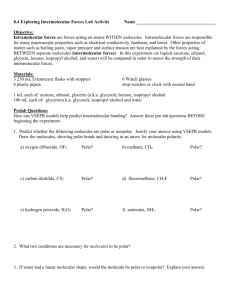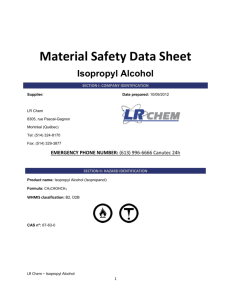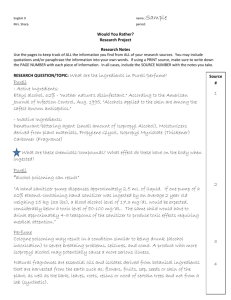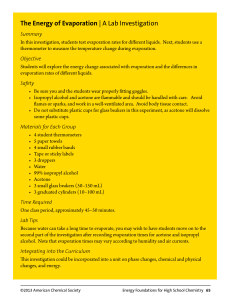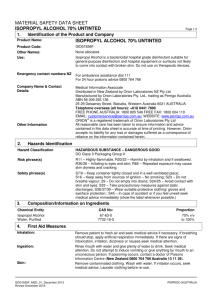LAB 8
advertisement
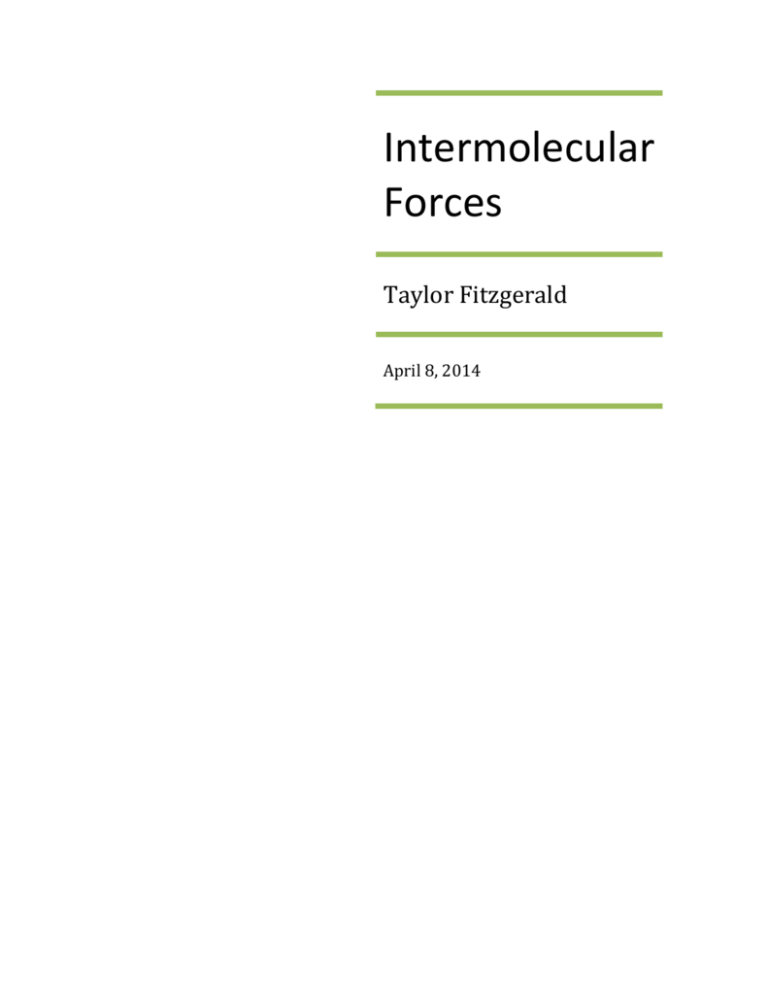
Intermolecular Forces Taylor Fitzgerald April 8, 2014 CHE1020 Spring 2014 TO: Professor Michelle Sama FROM: Taylor Fitzgerald, CIT student LAB PARTNER: Ashley Casey DATE: April 8, 2014 SUBJECT: Intermolecular Forces 1) Droplet Weight Droplet Width Water Acetone Glycerol 0.05 cm Isopropyl Alcohol 0.05 cm 0.30 cm 0.80 cm 2.90 cm 2.00 cm 1.00 cm 0.40 cm 2) Water 17 Number of Droplets Isopropyl Alcohol 21 3) Number of Droplets Evaporation Time Water Acetone Glycerol 1 Isopropyl Alcohol 1 1 9 minutes 23 seconds 0 minutes 58 seconds 4 minutes 51 seconds >9 minutes 23 seconds 1 4) No table 5) Observations Water Floats Isopropyl Alcohol Immediately sunk Under Tension? Yes, quickly No Glycerol Expanded quickly from where the pepper was shook, and it was floating Yes, slowly 1 CHE1020 Spring 2014 QUESTIONS: 1. Why did the droplets on the wax paper form different sized droplets? Explain in detail what could be occurring to dictate droplets sizes. The droplets on the wax paper formed different size droplets because of the product that they were. They all expanded. What could/might dictate the droplet sizes are the surface tension and the viscosity. 2. Based on the droplet test, which liquid appears to have the greater surface tension and greater intermolecular forces? Why? Isopropyl Alcohol appeared to have the greater surface tension and intermolecular forces. More drops could fit on the penny verses the water. 3. What forces are present that can explain why a paper clip floats on the surface? What do you think will happen if you did the same experiment, but used Isopropyl Alcohol instead? I think hydrogen bonding was present, hence why the paper clip floats. I think the Isopropyl Alcohol would allow it to float because there are more hydrogen atoms. 4. Determine if each of the liquids tested are polar or non-polar: Water (H2O): Polar Isopropyl Alcohol (C3H7OH): Non-polar Acetone ((CH3)2CO): Polar Glycerol (C3H8O3): Polar 5. Which of the liquids you tested displayed the greatest surface tension? Water: H20 6. How do you observations of surface tension and determination of polarity relate to molecular attractions in your liquids? All the liquids that were polar had surface tension. 7. Below is a list of relative masses for each molecule we have been testing. Recall that molecules with higher masses tend to have higher melting points as long as their intermolculer forces are the same. Look up the boiling points of each substance and record these values along with the masses given below. What conclusions can you make about the boiling point? The higher the boiling point, the higher the surface tension would be. Masses Boiling Point Water Acetone 18 g/mol 100 ˚C 58.08 g/mol 56 ˚C Isopropyl Alcohol 60.1 g/mol 82.5 ˚C Glycerol 92.09 g/mol 290 ˚C 2

